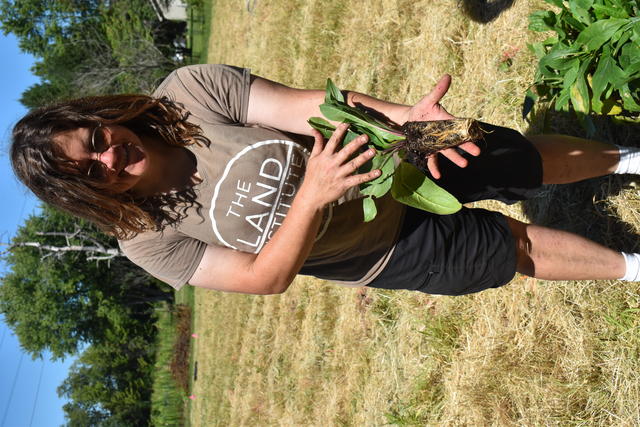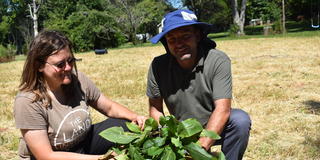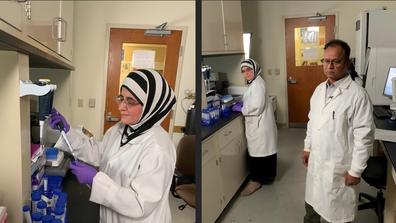
Six Questions for the Researcher: Silflowers to increase production and honey yield

Central State University research professor Marcus Nagle, Ph.D., Ebony Murrell, Ph.D., of the Land Institute in Salina, Kansas, and a team of researchers from both institutions completed planting silflower on a plot in Beavercreek Township in early September. They are testing integrating the perennial crop for increased production and honey yield.
The teams believe their work planting silflower on six plots in Wilberforce, Beavercreek, Spring Valley, and Springfield, Ohio, will help curb gas emissions from agricultural land and replenish nutrients lost from the soil.
Nagle and Hongmei Li-Byarlay, Ph.D., are Central State research professors partnering with Murrell, lead scientist at the Land Institute, in domesticating silflowers on the six-quarter-acre plots to test the viability of the perennial crop for increased production, pollinator activity, and honey yield. Nagle and Murrell were working at the last of the six plots in Beavercreek Township in early September when Cyril Ibe, communications and media specialist at CSU, talked with them on-site about their project. Their answers have been edited for clarity and brevity.
Planting silflower crops on local farms for pollinator activity, honey yield, and climate mitigation
Area showcase plots funded with $475,000 USDA grant to CSU
Q: Dr. Nagle, what do you hope this particular farm (in Beavercreek Township) will turn into for your research project?

Nagle: Well, these plots are just test plots. They're too small to be productive from an economic or agricultural sense. We hope these will be showcased for people interested in this kind of agricultural production. You may know that many of our crops are annual crops. That means we need to reseed them every year. And our agricultural systems are intensive systems. They're highly mechanized, so they're not necessarily labor-intensive but very intensive agricultural systems. These perennial crops, even though it looks labor intensive now getting these things established, require very little management in the end. As Dr. Murrell mentioned, they end up growing on their own and sustaining themselves without inputs. I suspect that a lot of landowners, particularly small-farm landowners, will be interested in this crop for a variety of reasons that I just stated. We'll establish these plots as showcases and demonstrations for information for local and regional Ohioans interested in these agricultural systems.
The objective of the project is to see integrated systems. This being a very pollinator-friendly species crop, our treatments will be the silflower fields together with honeybees, because we expect that the presence of the honeybees will increase pollination and lead to a higher yield of seeds. That's the economically interesting part of the crop. Then, there is the increased availability of nectar and pollen because these plants flower in late summer and early fall when there's a scarcity of resources for the honeybees. We expect the increased availability of nectar and pollen will also increase the honey yield.
Q: Do you have an eye at some other locations where, if this becomes a good showcase, you would like to target in Ohio to expand? Is that part of the dream?
Nagle: Within this project, we have six sites planted with this crop now.
This is our last one today. Two of them are at CSU. I especially expect that those will serve as real demonstrations through our Cooperative Extension services. Those sites will be available to disseminate knowledge and information about these agricultural systems. I think that people are interested in sustainability. They're interested in climate change and crops or plants that harvest and capture carbon. They're interested in pollinators. So, this plant produces a very showy and fragrant flower that attracts not only honeybees but also a lot of our native pollinators, who will be attracted to these crops, and that will cause these areas and these systems to be highly biodiverse. And people are interested in that now. And I do expect that we will have a lot of people who want to try to get this going on their land. Maybe Ohio will be the No. 1 silphium (the scientific name for silflower) producer here in a short while.
Q: Why are people interested in these kinds of farms?
Nagle: Because our big (commercial) agriculture is not for everybody, and a lot of people look at it and think that it's not sustainable. So, people look for alternative and regenerative options for their land.
Q: Dr. Murrell, what is your personal involvement and that of your institution in this project?
Murrell: The Land Institute is a nonprofit research organization, and we are the people who are responsible for developing perennial grain crops, and silflower is one of the crops we're developing. So, our major role has been providing some seedlings for Marcus and his program to plant and transplant. We're assisting with transplanting. We're also providing education and information about our perennial grains to the Central State University program and the farmers participating in this project. My program is participating, so it's myself, my technician, and the people associated with my program.
Q: What are your expectations for this project at the end of three years?
A: Well, we're very excited about this project because it will provide us with our first on-farm research data regarding the economic benefits of silflower at a crop level. We've certainly done a lot of breeding of individual plants and assessing those traits. Still, here we're planting the crops on quarter-acre plots. We're excited to collaborate with Central State University because we feel that Marcus and Hongmei and their programs here are mutually beneficial in promoting research and getting exciting new crops like this on the landscape. Silflower is native to many of the states where prairie (grows). It's much more common in places like Illinois, Iowa, Wisconsin, and Kansas. Kansas silflower still grows wild in the ditches. That's the region that it came from. However, as you know, the prairie has been largely exterminated in many areas where it used to grow. So even though silflower was probably native to Ohio at one time, it's no longer here. So this is a place where it should be able to grow very well, but it doesn't currently. We're excited about it growing here because it has a lot of potential to grow and be very healthy and happy here.
Q: What are the benefits of silflower?
Dr. Murrell: The benefit of silflower and other perennial crops is that they have very deep root systems. So, having those deep root systems is essential for drought tolerance. Once they are established, they don't have to be watered. They're very, very resistant to drought. It's also really important for sequestering carbon from the atmosphere. So trees are very well known for capturing carbon from the atmosphere in the form of CO2. Our perennial crops do much the same thing. The silflower's root systems can be more than three meters deep. They're very deep. And so they can potentially sequester a lot of carbon from the atmosphere. They don't have to be watered. They can live a very long time. If they can provide a good crop to the farmer, we hope that they can be harvested for grain and allowed to re-grow year after year without tilling the soil, without having to put a lot of inputs into the plant to get it to grow and survive.


